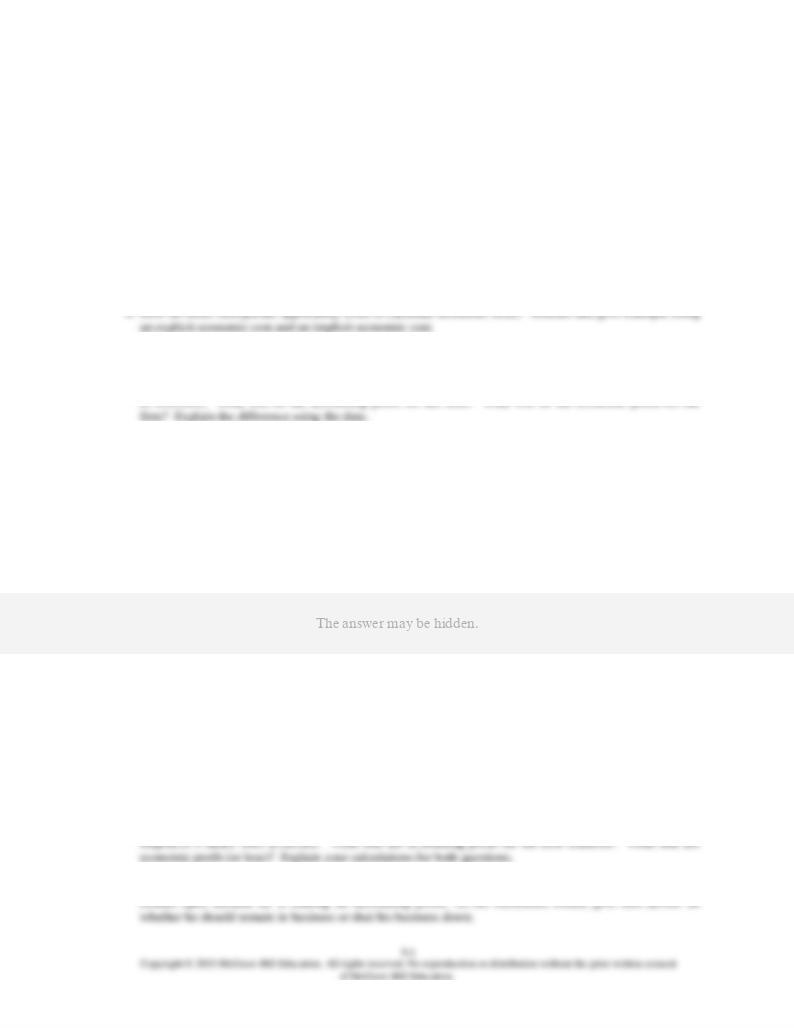
CHAPTER 9
Businesses and the Costs of Production
A. Short-Answer, Essays, and Problems
1. Why are costs important in economics?
2. Why don’t economists use the same cost data as accountants use?
3. What is the real cost of putting an unemployed laborer to work raking leaves or digging holes and refilling
them during a severe recession? Explain.
5. Why is it important to distinguish between explicit and implicit costs?
6. Your firm has total sales revenue of $1,000,000 and total explicit costs of $600,000 and total implicit cost
7. Why must normal profits be counted as a cost, according to economists?
8. Evaluate this statement: “If the economic profit is zero, a business will shut down.”
9. Jane quit her job at IBM where she earned $50,000 a year. She cashed in $50,000 in corporate bonds that
earned 10% interest annually to buy a mini-bus. Jane has decided to buy the mini-bus and set up a
commuter service between Lincoln and Omaha. There are 1000 people who will pay $400 a year each for
the commuter service; $280 from each person goes for gas, maintenance, insurance, and depreciation. She
estimates that her entrepreneurial skills would have typically yielded a normal profit of $5,000 in another
business.
10. Debbie was earning $100,000 a year working as a scientist for a drug company. She decided to start her
own business that conducted drug trials. She estimates this entrepreneurial talent or forgone
entrepreneurial income to be $10,000 a year. She used $500,000 in savings that earned 5 percent interest
annually to finance the new business. In the first year, the firm earned revenue of $1,500,000. The costs
for rent, supplies, and employees’ salaries were $1,100,000. What was the accounting profit for the new
business? What was the economic profit (or loss)? Explain your calculations for both questions.
11. Tomas quit his job at the Tri-City bank where he earned $50,000 a year to start his own businesses, a bank
marketing company. He estimates his entrepreneurial talent or forgone entrepreneurial income to be
$5,000 a year. He used $100,000 in savings that earned 5 percent interest annually to finance the new
business. In the first year, the firm earned revenue of $250,000. The costs for rent, supplies, and an
12. John is determining whether he should close his construction firm. His accountant has advised him to
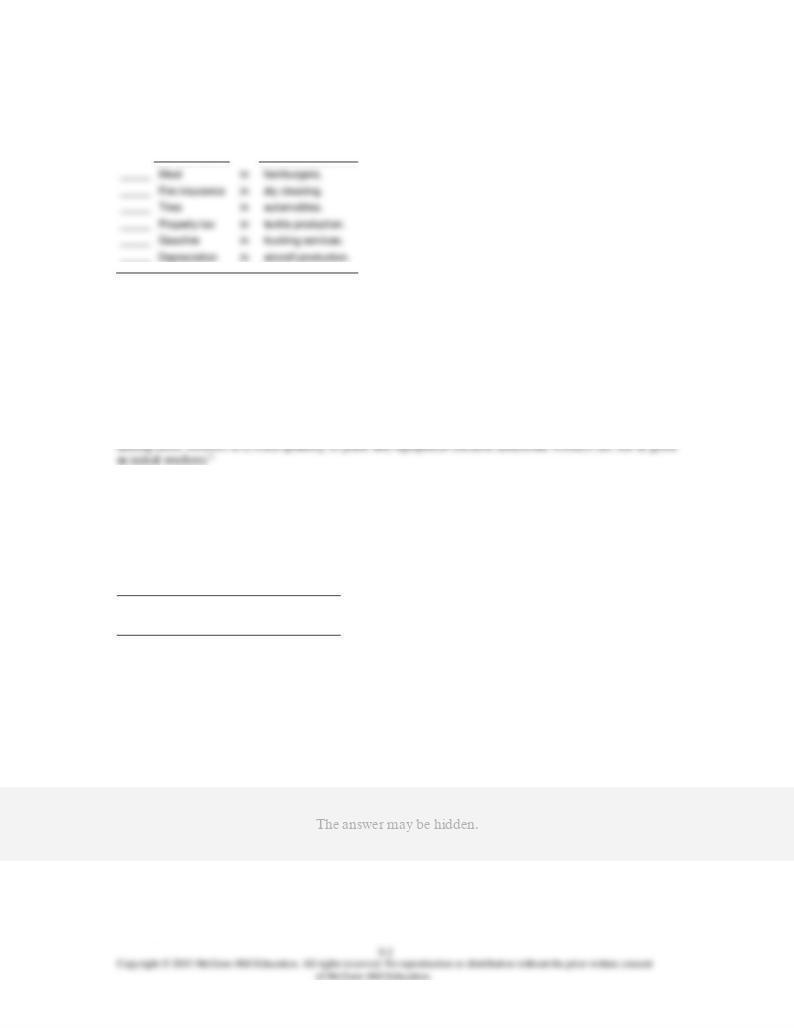
12. Why is the distinction between fixed and variable cost important?
13. Indicate whether the inputs below are variable (V) or fixed (F) in the short run.
Input
Output
14. What is the difference between the short run and the long run?
15. Explain the difference between total product, marginal product and average product.
16. What is the relationship between total product, marginal product, and average product shown by the law of
diminishing returns?
17. Interpret this statement: “If diminishing returns did not occur, the world could be fed out of a flower pot.”
18. Comment on the problem with this statement: “Of course, there are diminishing marginal returns from
19. What is the law of diminishing returns? Give a descriptive example.
20. (Consider This) How can total course learning and studying be related to the law of diminishing returns?
21. The table below shows the total production of a firm as the quantity of labor employed increases. The
quantities of all other resources employed are constant. Compute the marginal and average products and
enter them in the table.
Inputs of
labor
Total
product
Marginal
product of
labor
Average
product of
labor
0
0
—
—
1
40
_____
_____
2
100
_____
_____
3
165
_____
_____
4
200
_____
_____
5
225
_____
_____
6
240
_____
_____
7
245
_____
_____
8
240
_____
_____
22. Explain: “Whenever a number which is less than the previous average of a total is added to that total, the
average will necessarily fall. Conversely, whenever a number which is greater than the previous average of
a total is added to that total, the average will necessarily rise.” How does this help explain the relationship
between the various short-run cost curves? Between the various productivity curves?
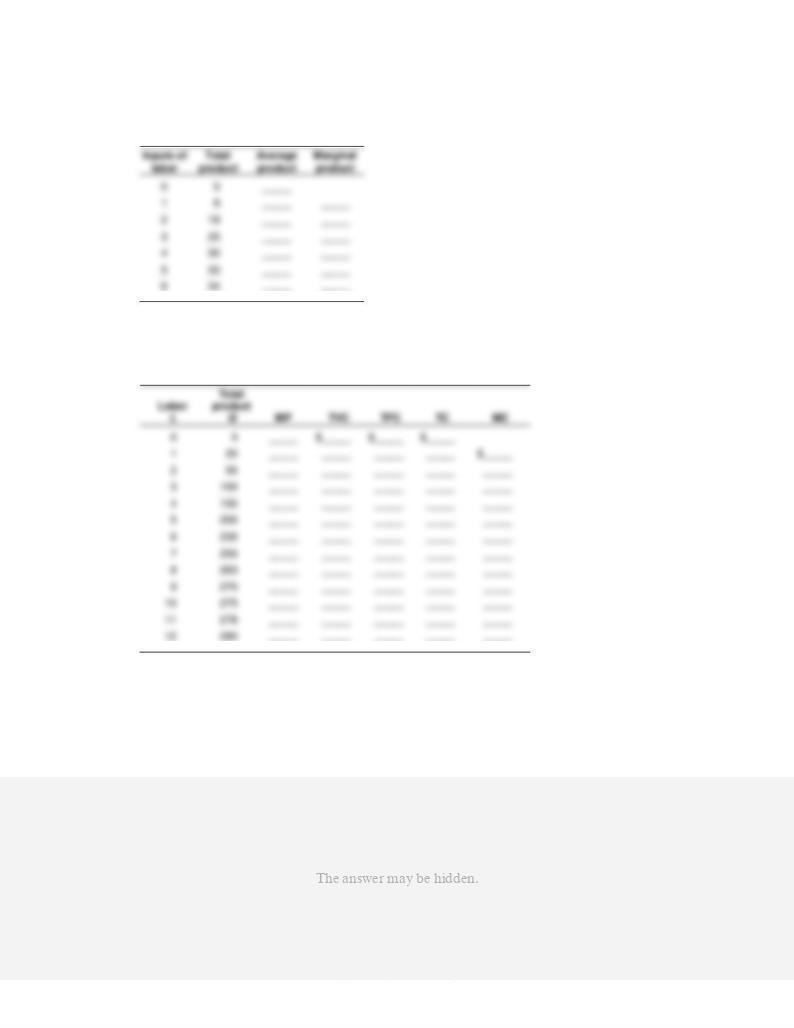
23. Complete the following table by finding the average and marginal product. At what input-output level will
average variable cost begin to rise? Explain.
24. You are given the following short-run information for an individual firm. Labor (L) is the only variable
input. The price of labor is $200/week. Fixed costs are $100/week. Complete the rest of the table.
Describe the relationship between the MP and MC. At which output level does the law of diminishing
returns set in?
25. What is the relationship between marginal cost and marginal product?
26. Why does the short-run marginal-cost curve eventually increase for the typical firm?
27. Assume that a firm has a plant of fixed size and that it can vary its output only by varying the amount of
labor it employs. The table below shows the relationships among the amount of labor employed, the output
of the firm, the marginal product of labor, and the average product of labor.

(e) Describe the relationship between the average product of labor and the average variable cost.
1
10
10
10.00
$_____
$_____
$_____
2
22
12
11.00
_____
_____
_____
3
36
14
12.00
_____
_____
_____
4
48
12
12.00
_____
_____
_____
5
58
10
11.60
_____
_____
_____
6
66
8
11.00
_____
_____
_____
7
72
6
10.28
_____
_____
_____
8
76
4
9.50
_____
_____
_____
9
78
2
8.66
_____
_____
_____
10
78
0
7.80
_____
_____
_____
28. Assume a firm has fixed costs of $80 and variable costs as indicated in the table below. Complete the cost
table.
29. Complete the following short-run cost table using the information provided.
Total
product
TFC
AFC
TVC
AVC
TC
MC
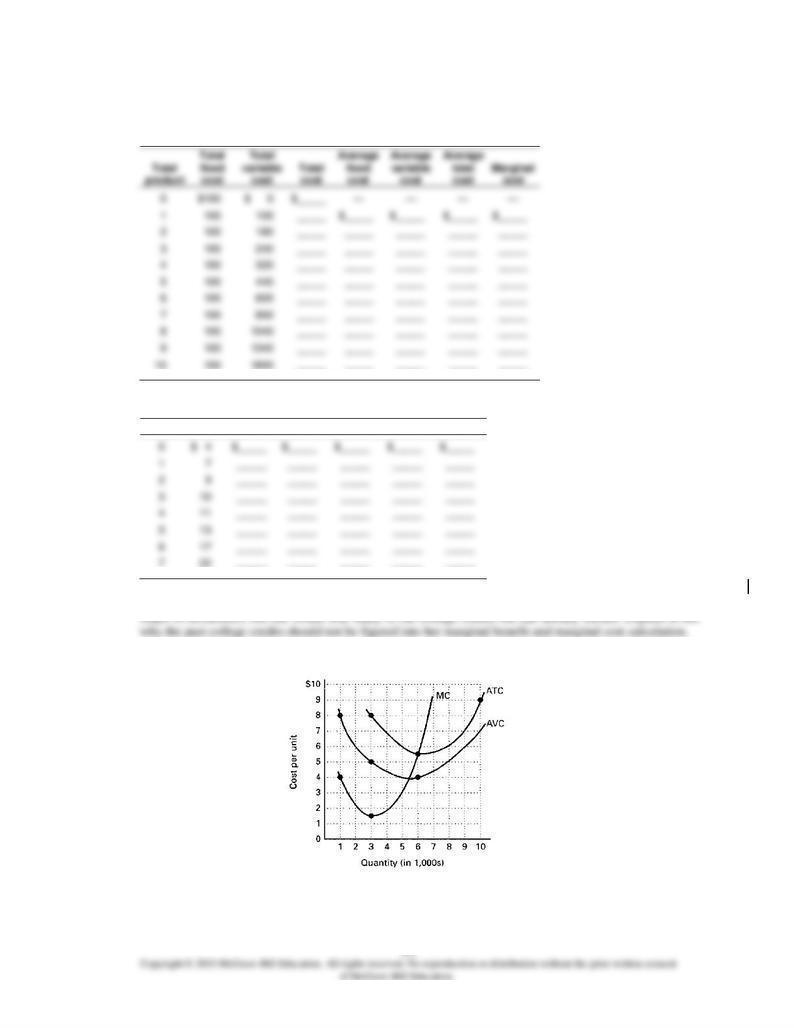
30. In the table below you will find a schedule of a firm’s fixed cost and variable cost. Complete the table by
computing total cost, average fixed cost, average variable cost, average total cost, and marginal cost.
31. Complete the following short-run cost table using the information provided.
Q
TC
TFC
TVC
AVC
ATC
MC
32. (Consider This) Suppose your friend is currently a nursing major. She decides she wants to switch her
32.Answer the questions below on the basis of the diagram.
(a) How can you tell if these cost curves are for the short run or the long run?
(b) What does the graph indicate about:
(1) AVC at 6000 units of output?
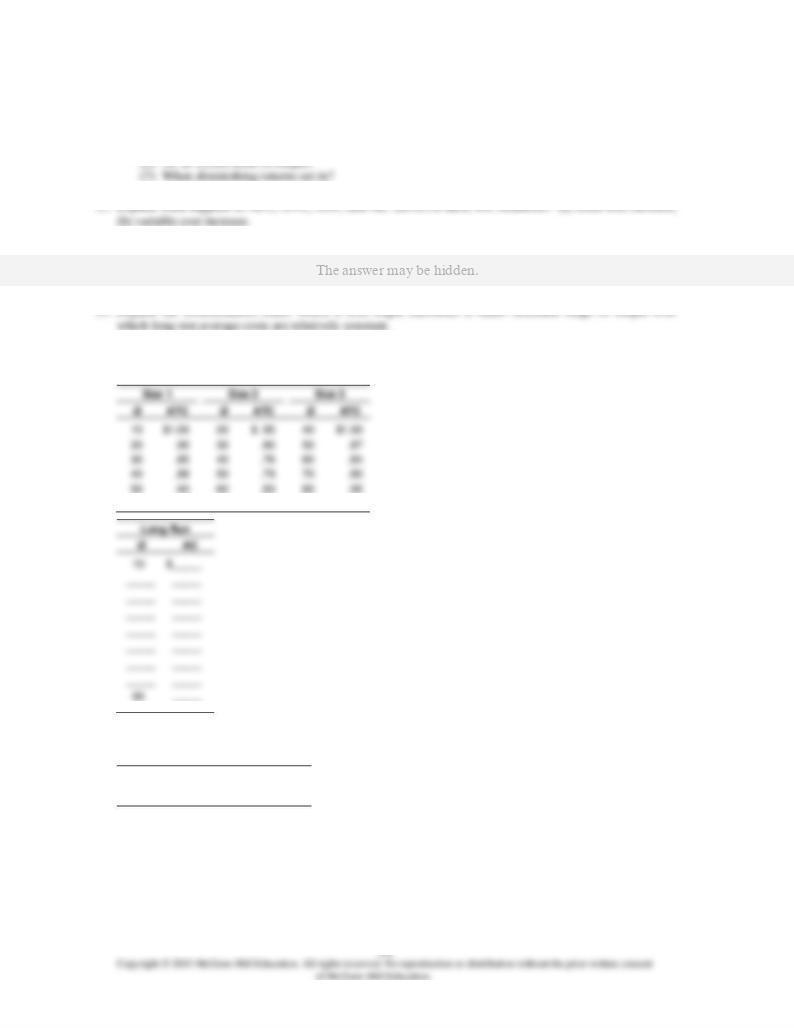
(2) ATC at 6000 units of output?
(3) AFC at 6000 units of output?
(4) TVC at 6000 units of output?
(5) TFC at all levels of output?
36. The following are three short-run average total cost schedules for the only three possible plant sizes, 1, 2,
and 3. Find the long-run average cost schedule and show the result in the second table.
60
1.05
70
.90
90
1.05
37. In the table below are data from a book company that prints and binds special-order books. The data show
various quantities that can be produced by the firm in an hour and the unit costs of each quantity.
(1)
Quantity of
books
(2)
Unit cost A
of books
(3)
Unit cost B
of books
100
$70
$_____
200
60
_____
300
50
_____
400
40
_____
500
35
_____
600
30
_____
700
35
_____
800
45
_____

900
60
_____
1000
80
_____
38. Below are the short-run average-total-cost schedules for three plants of different size that a firm might
build to produce its product. Assume that these are the only possible sizes of plants that the firm might
build. What is the long-run average-cost schedule for the firm? Show it in the second table below.

Output
Average cost
39. How can diseconomies of scale occur at larger capacities?
40. What factors explain economies of scale?
41. What is minimum efficient scale? What insights would it give about the size of firms in an industry?
42. The values for the long-run ATC curves of three different firms are listed in the table below.
Quantity
ATC 1
ATC 2
ATC 3
5
10
7
12
10
8
6
9
15
7
5
7
20
6
6
6
25
6
7
5
30
6
9
4
35
7
13
6
43. Consider the diagram below. Curves 1–8 are the short-run curves which occur with different plant sizes.
Answer the next two questions.
(a) On the graph show the range of outputs for: (1) economies of scale; (2) diseconomies of scale:
Indicate (3) minimum efficient scale.
(b) In the long run, what plant size should the firm build if it wants to produce: (1) 6000 units; (2) 14,000
units?
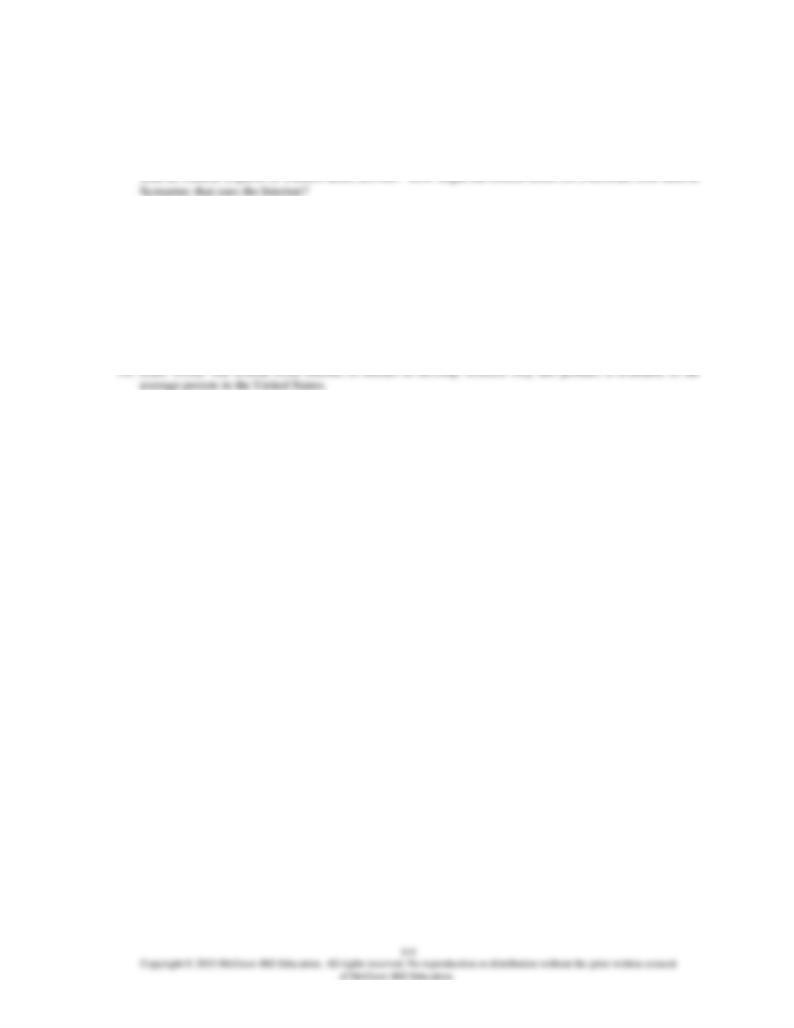
44. What effect does the increase of the price of corn have on the cost curves of a firm producing items like
cereal, tortilla shells and chewing gum?
45. What effect does the increase of the price of gasoline have on the cost curves of package delivery firms
46. What are some of the sources of cost savings for recent business start-ups in the U.S. economy such as
Intel, Starbucks, Microsoft, Dell, Google and Cisco Systems?
47. How would a Verson stamping machine help a firm achieve economies of scale?
48. Explain how the Internet has affected the average fixed cost of a daily print newspaper.
49. Why are there two plants run by one firm that produce large commercial aircraft and thousands of plants
run by hundreds of firms that produce ready-mix concrete? Explain in terms of economies of scale.
51. (Last Word) Discuss how the 3-D printer is set to make manufactured goods more affordable for the average
person in the United States.
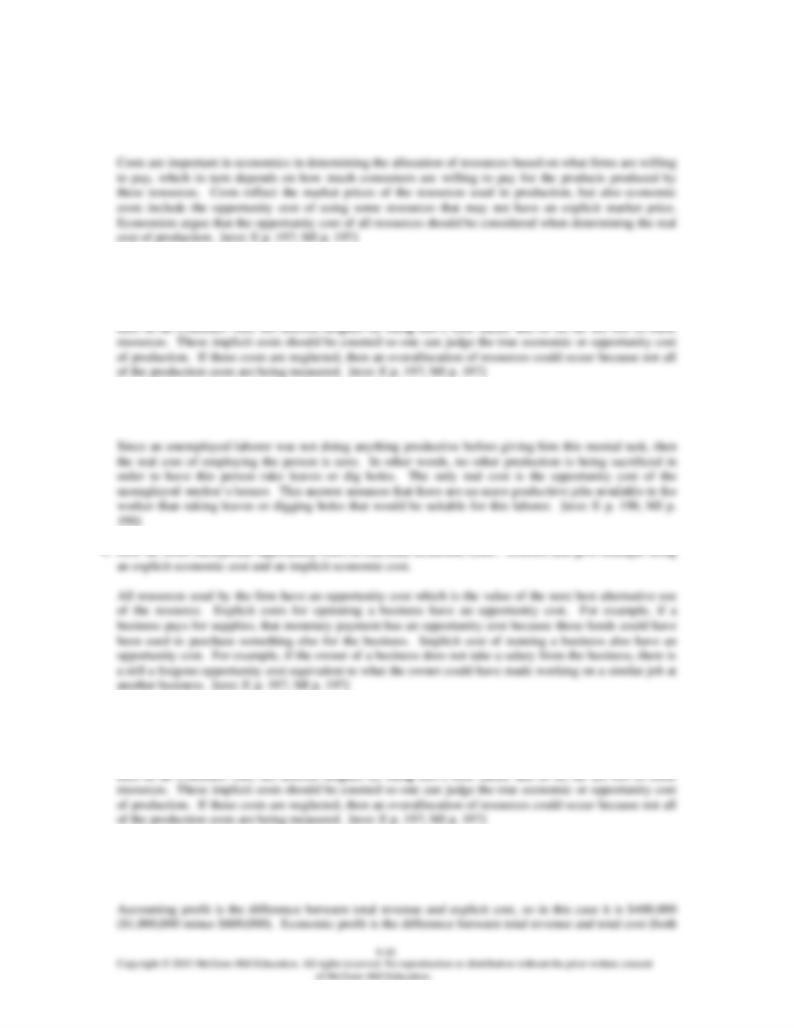
B. Answers to Short-Answer, Essays, and Problems
1. Why are costs important in economics?
2. Why don’t economists use the same cost data as accountants use?
Implicit costs are as important as the explicit costs which are generally the so-called “accounting costs.”
For example, economists (but not accountants) would count the income forgone in the use of the owner’s
3. What is the real cost of putting an unemployed laborer to work raking leaves or digging holes and refilling
them during a severe recession? Explain.
5. Why is it important to distinguish between explicit and implicit costs?
Implicit costs are as important as the explicit costs which are generally the so-called “accounting costs.”
For example, economists (but not accountants) would count the income forgone in the use of the owner’s
6. Your firm has total sales revenue of $1,000,000 and total explicit costs of $600,000 and total implicit cost
of $300,000. What will be the accounting profit for the firm? What will be the economic profit for the
firm? Explain the difference using the data.
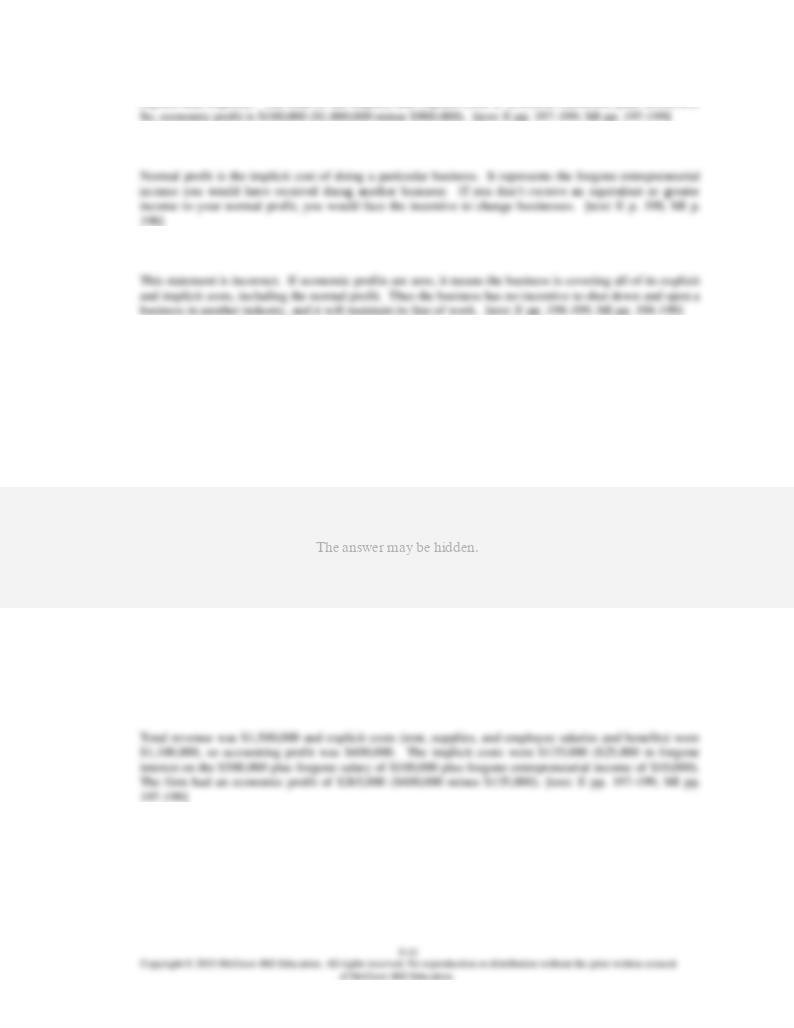
explicit and implicit). The total of the implicit and explicit costs is $900,000 ($600,000 plus $300,000).
7. Why must normal profits be counted as a cost, according to economists?
8. Evaluate this statement: “If the economic profit is zero, a business will shut down.”
9. Jane quit her job at IBM where she earned $50,000 a year. She cashed in $50,000 in corporate bonds that
earned 10% interest annually to buy a mini-bus. Jane has decided to buy the mini-bus and set up a
commuter service between Lincoln and Omaha. There are 1000 people who will pay $400 a year each for
the commuter service; $280 from each person goes for gas, maintenance, insurance, and depreciation. She
estimates that her entrepreneurial skills would have typically yielded a normal profit of $5,000 in another
business.
(a) Complete the following questions: (1) What are Jane’s total revenues? (2) What are Jane’s explicit
costs? (3) What is her accounting profit?
(b) List the important implicit costs that Jane has not included.
10. Debbie was earning $100,000 a year working as a scientist for a drug company. She decided to start her
own business that conducted drug trials. She estimates this entrepreneurial talent or forgone
entrepreneurial income to be $10,000 a year. She used $500,000 in savings that earned 5 percent interest
annually to finance the new business. In the first year, the firm earned revenue of $1,500,000. The costs
for rent, supplies, and employees’ salaries were $1,100,000. What was the accounting profit for the new
business? What was the economic profit (or loss)? Explain your calculations for both questions.
11. Tomas quit his job at the Tri-City bank where he earned $50,000 a year to start his own businesses, a bank
marketing company. He estimates his entrepreneurial talent or forgone entrepreneurial income to be
$5,000 a year. He used $100,000 in savings that earned 5 percent interest annually to finance the new
business. In the first year, the firm earned revenue of $250,000. The costs for rent, supplies, and an
employee’s salary were $200,000. What was the accounting profit for the new business? What was the
economic profit (or loss)? Explain your calculations for both questions.
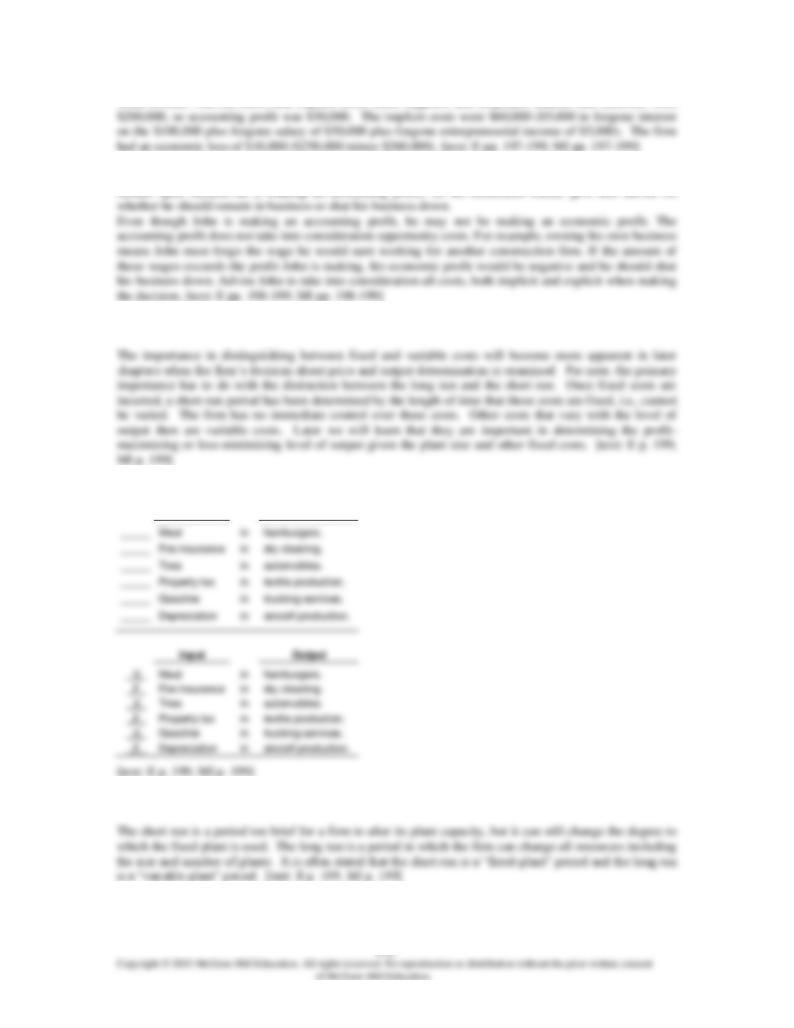
Total revenue was $250,000 and explicit costs (rent, supplies, and employee salaries and benefits) were
12. John is determining whether he should close his construction firm. His accountant has advised him to
12. Why is the distinction between fixed and variable cost important?
13. Indicate whether the inputs below are variable (V) or fixed (F) in the short run.
Input
Output
14. What is the difference between the short run and the long run?
15. Explain the difference between total product, marginal product and average product.
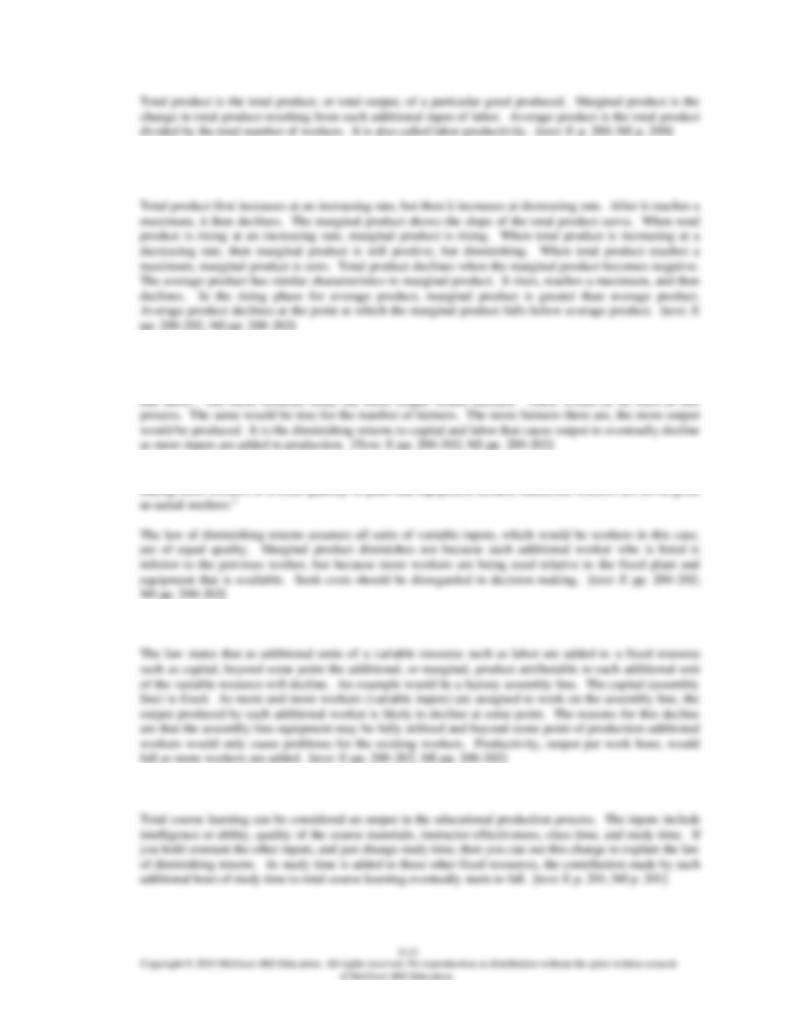
16. What is the relationship between total product, marginal product, and average product shown by the law of
diminishing returns?
17. Interpret this statement: “If diminishing returns did not occur, the world could be fed out of a flower pot.”
If diminishing returns did not occur, the world could be fed out of a flower pot by simply increasing inputs
18. Comment on the problem with this statement: “Of course, there are diminishing marginal returns from
19. What is the law of diminishing returns? Give a descriptive example.
20. (Consider This) How can total course learning and studying be related to the law of diminishing returns?
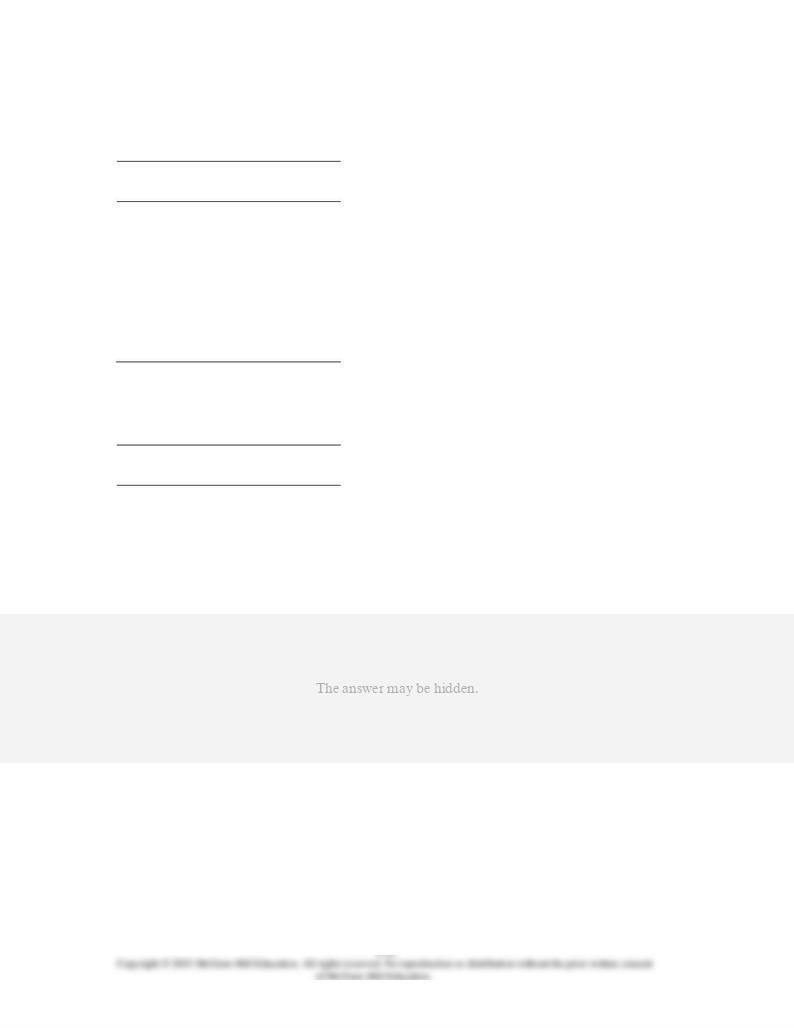
21. The table below shows the total production of a firm as the quantity of labor employed increases. The
quantities of all other resources employed are constant. Compute the marginal and average products and
enter them in the table.
Inputs of
labor
Total
product
Marginal
product of
labor
Average
product of
labor
0
0
—
—
1
40
_____
_____
2
100
_____
_____
3
165
_____
_____
4
200
_____
_____
5
225
_____
_____
6
240
_____
_____
7
245
_____
_____
8
240
_____
_____
(a) At what levels are there increasing returns to labor and at what levels are there decreasing returns to
labor?
(b) Describe the relationship between the total product and marginal product.
(c) Describe the relationship between marginal and average product.
Inputs of
labor
Total
product
Marginal
product of
labor
Average
product of
labor
0
0
1
40
40
40
2
100
60
50
3
165
65
55
4
200
35
50
5
225
25
45
6
240
15
40
7
245
5
35
22. Explain: “Whenever a number which is less than the previous average of a total is added to that total, the
average will necessarily fall. Conversely, whenever a number which is greater than the previous average of
a total is added to that total, the average will necessarily rise.” How does this help explain the relationship
between the various short-run cost curves? Between the various productivity curves?
The statement is simply a fact of arithmetic. To find an average, one sums up the relevant numbers and
divides by n, the number of those numbers. The addition of a new number means the sum must now be
divided by (n + 1) to get the new average.
This helps explain the relationship between the marginal cost curve and the average variable and average
total cost curves. Whenever the marginal cost curve is below the average cost curve, it is like the addition

of a number below the average, and the average cost curve (variable or total) will be falling. Whenever the
marginal cost becomes greater than either average cost curve, that average cost will rise.
23. Complete the following table by finding the average and marginal product. At what input-output level will
average variable cost begin to rise? Explain.
3
25
8.33
7
4
30
7.50
5
5
33
6.60
3
6
34
5.67
1
24. You are given the following short-run information for an individual firm. Labor (L) is the only variable
input. The price of labor is $200/week. Fixed costs are $100/week. Complete the rest of the table.
Describe the relationship between the MP and MC. At which output level does the law of diminishing
returns set in?

Total
2
55
35
400
100
500
5.71
3
100
45
600
100
700
4.41
4
150
50
800
100
900
4.00
5
200
50
1000
100
1100
4.00
6
230
30
1200
100
1300
6.66
7
250
20
1400
100
1500
10.00
8
263
13
1600
100
1700
15.38
9
270
7
1800
100
1900
28.57
10
275
5
2000
100
2100
40.00
11
278
3
2200
100
2300
66.66
12
280
2
2400
100
2500
100.00
25. What is the relationship between marginal cost and marginal product?
26. Why does the short-run marginal-cost curve eventually increase for the typical firm?
27. Assume that a firm has a plant of fixed size and that it can vary its output only by varying the amount of
labor it employs. The table below shows the relationships among the amount of labor employed, the output
of the firm, the marginal product of labor, and the average product of labor.
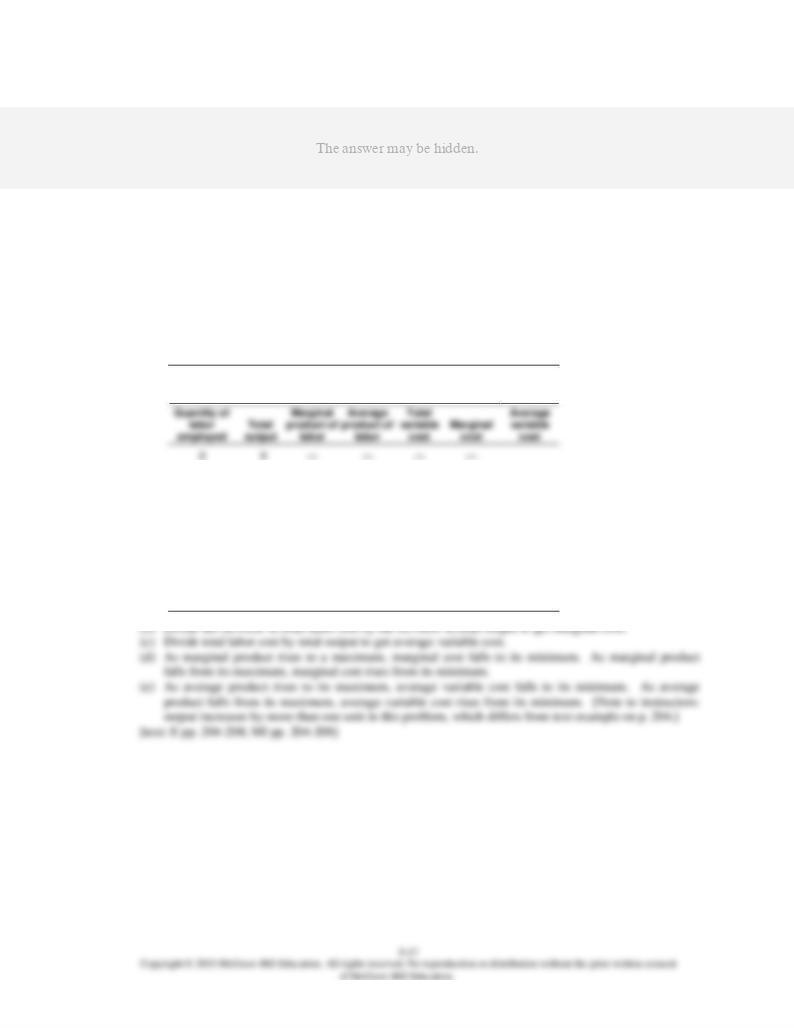
(e) Describe the relationship between the average product of labor and the average variable cost.
1
10
10
10.00
$_____
$_____
$_____
2
22
12
11.00
_____
_____
_____
3
36
14
12.00
_____
_____
_____
4
48
12
12.00
_____
_____
_____
5
58
10
11.60
_____
_____
_____
6
66
8
11.00
_____
_____
_____
7
72
6
10.28
_____
_____
_____
8
76
4
9.50
_____
_____
_____
9
78
2
8.66
_____
_____
_____
10
78
0
7.80
_____
_____
_____
(a) See table.
1
10
10
10.00
$ 20
$2.00
$2.00
2
22
12
11.00
40
1.67
1.82
3
36
14
12.00
60
1.43
1.67
4
48
12
12.00
80
1.67
1.67
5
58
10
11.60
100
2.00
1.72
6
66
8
11.00
120
2.50
1.82
7
72
6
10.28
140
3.33
1.94
8
76
4
9.50
160
5.00
2.10
9
78
2
8.66
180
10.00
2.31
10
78
0
7.80
200
—
2.56
(b) Divide the increase in total labor cost by the increase in total output to get marginal cost.
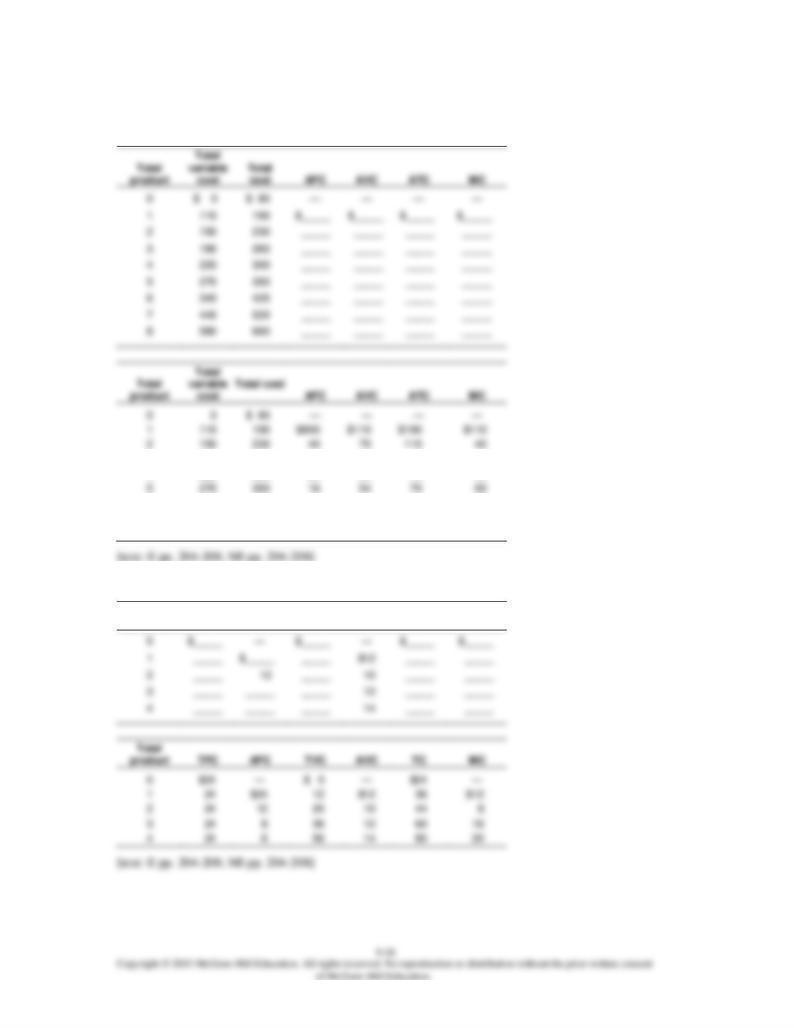
28. Assume a firm has fixed costs of $80 and variable costs as indicated in the table below. Complete the cost
table.
3
180
260
26.67
60
86.67
30
4
220
300
20
55
75
40
6
340
420
13.33
56.67
70
70
7
440
520
11.43
62.86
74.29
100
8
580
660
10
72.50
82.50
140
29. Complete the following short-run cost table using the information provided.
Total
product
TFC
AFC
TVC
AVC
TC
MC

30. In the table below you will find a schedule of a firm’s fixed cost and variable cost. Complete the table by
computing total cost, average fixed cost, average variable cost, average total cost, and marginal cost.
2
100
180
280
50.00
90.00
140.00
80
3
100
240
340
33.33
80.00
113.33
60
4
100
320
420
25.00
80.00
105.00
80
5
100
440
540
20.00
88.00
108.00
120
6
100
600
700
16.66
100.00
116.67
160
7
100
800
900
14.29
114.29
128.57
200
8
100
1040
1140
12.50
142.50
130.00
240
9
100
1340
1440
11.11
148.89
160.00
300
10
100
1800
1900
10.00
180.00
190.00
460
31. Complete the following short-run cost table using the information provided.
Q
TC
TFC
TVC
AVC
ATC
MC
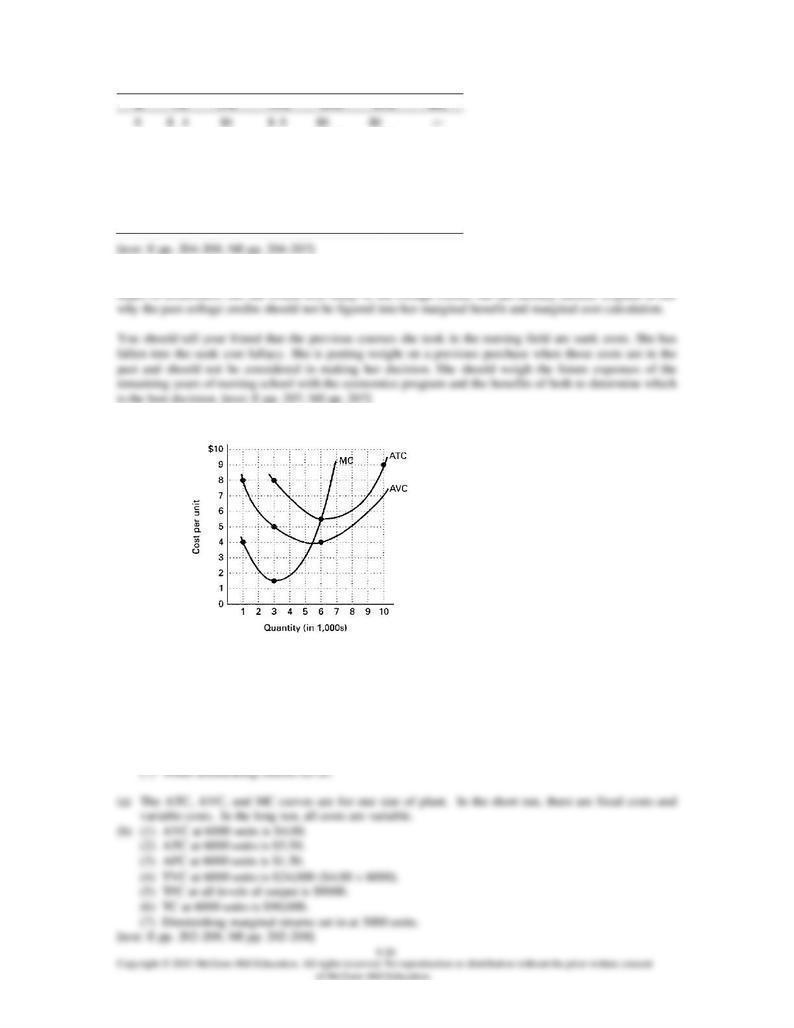
Q
TC
TFC
TVC
AVC
ATC
MC
1
7
4
3
3.00
7.00
$3
2
9
4
5
2.50
4.50
2
3
10
4
6
2.00
3.33
1
4
11
4
7
1.75
2.75
1
5
13
4
9
1.80
2.60
2
6
17
4
13
2.17
2.83
4
7
22
4
18
2.57
3.14
5
32. (Consider This) Suppose your friend is currently a nursing major. She decides she wants to switch her
32. Answer the questions below on the basis of the diagram.
(a) How can you tell if these cost curves are for the short run or the long run?
(b) What does the graph indicate about:
(1) AVC at 6000 units of output?
(2) ATC at 6000 units of output?
(3) AFC at 6000 units of output?
(4) TVC at 6000 units of output?
(5) TFC at all levels of output?
(6) TC at 10,000 units of output?
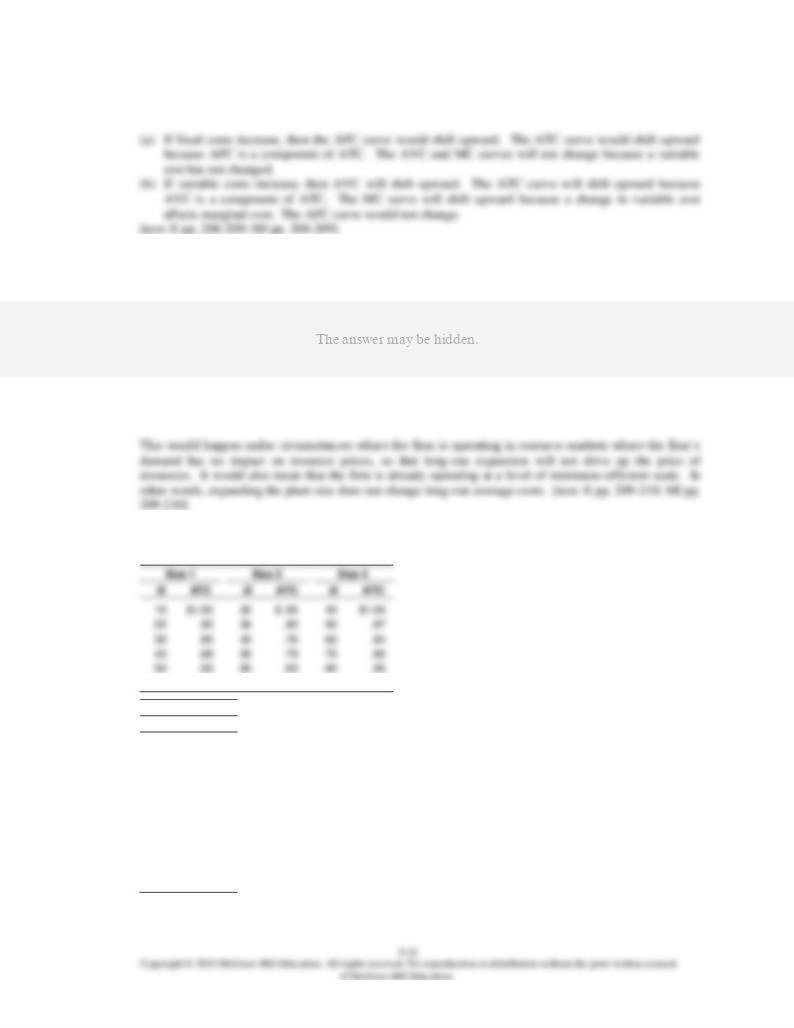
33. Explain what happens to AFC, AVC, ATC, and MC curves in these two situations: (a) fixed cost increase;
(b) variable cost increase.
34. What effect would each of the following have on the short-run average and marginal costs of an auto
dealership: (a) auto mechanics receive a 10% wage increase; (b) property taxes decrease; (c) auto dealers
institute a one-time only promotional campaign?
35. Explain the circumstances under which a firm might encounter a rather extended range of output over
which long-run average costs are relatively constant.
36. The following are three short-run average total cost schedules for the only three possible plant sizes, 1, 2,
and 3. Find the long-run average cost schedule and show the result in the second table.
60
1.05
70
.90
90
1.05
Long Run
Q
AC
10
$_____
_____
_____
_____
_____
_____
_____
_____
_____
_____
_____
_____
_____
_____
_____
90
_____
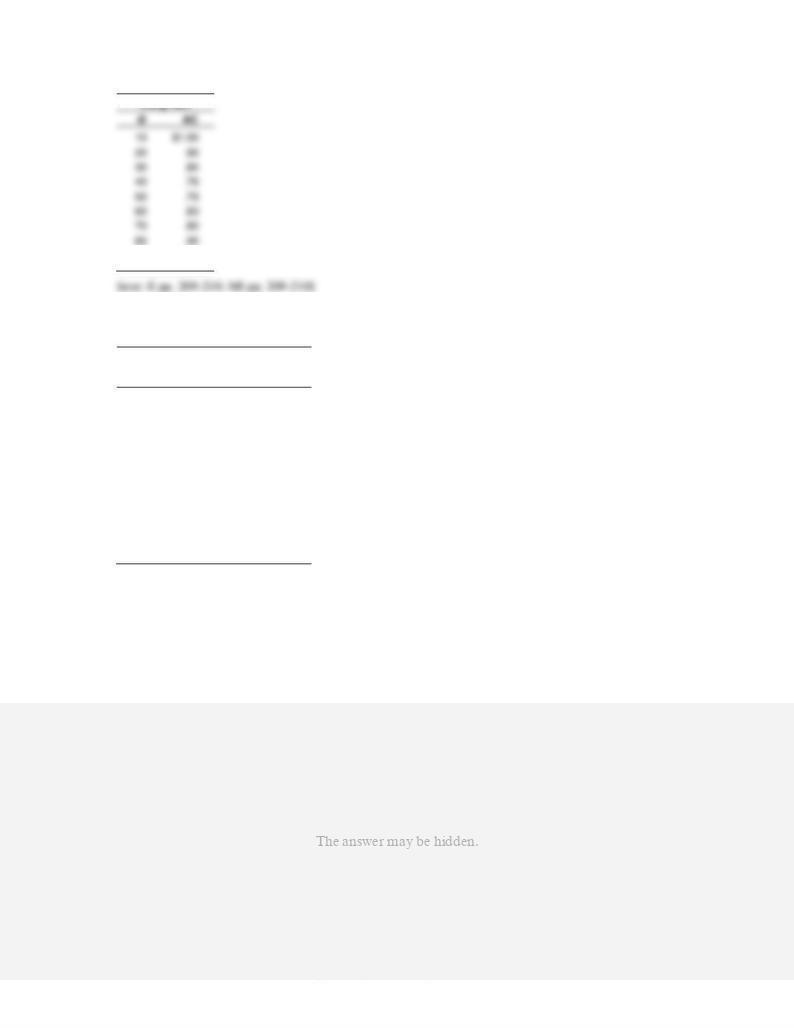
Long Run
90
1.05
37. In the table below are data from a book company that prints and binds special-order books. The data show
various quantities that can be produced by the firm in an hour and the unit costs of each quantity.
(1)
Quantity of
books
(2)
Unit cost A
of books
(3)
Unit cost B
of books
100
$70
$_____
200
60
_____
300
50
_____
400
40
_____
500
35
_____
600
30
_____
700
35
_____
800
45
_____
900
60
_____
1000
80
_____
(a) In the graph below, label the axes and plot the long-run average cost curve for this firm using the data
in columns 1 and 2 of the table above.
(b) The firm then decides to subcontract the binding work to another company that specializes in the
binding of books. As a consequence, the unit costs of the firm are decreased by $20 at each output
level. Fill in column 3 of the table, and then graph the new long-run average cost curve B for the firm
on the graph.
(c) What will be the minimum cost with unit cost A? With unit cost B?
(d) If the firm produces 400 books, what will be the cost with curve A? With curve B?

(c) The minimum cost with A will be $30 at 600 units. The minimum cost with B will be $10 with 600
38. Below are the short-run average-total-cost schedules for three plants of different size that a firm might
build to produce its product. Assume that these are the only possible sizes of plants that the firm might
build. What is the long-run average-cost schedule for the firm? Show it in the second table below.
Plant size X
Plant size Y
Plant size Z
Output
ATC
Output
ATC
Output
ATC
5
$10
5
$13
5
$72
10
9
10
12
10
65
15
8
15
11
15
52
20
7
20
10
20
41
25
6
25
8
25
33
30
9
30
7
30
20
35
12
35
9
35
15
40
18
40
12
40
14
45
20
45
17
45
12
50
23
50
19
50
14
55
29
55
25
55
20
60
31
60
33
60
30
Output
Average cost
5
$_____
10
_____
15
_____
20
_____
25
_____
30
_____
35
_____
40
_____
45
_____
50
_____
55
_____
60
_____
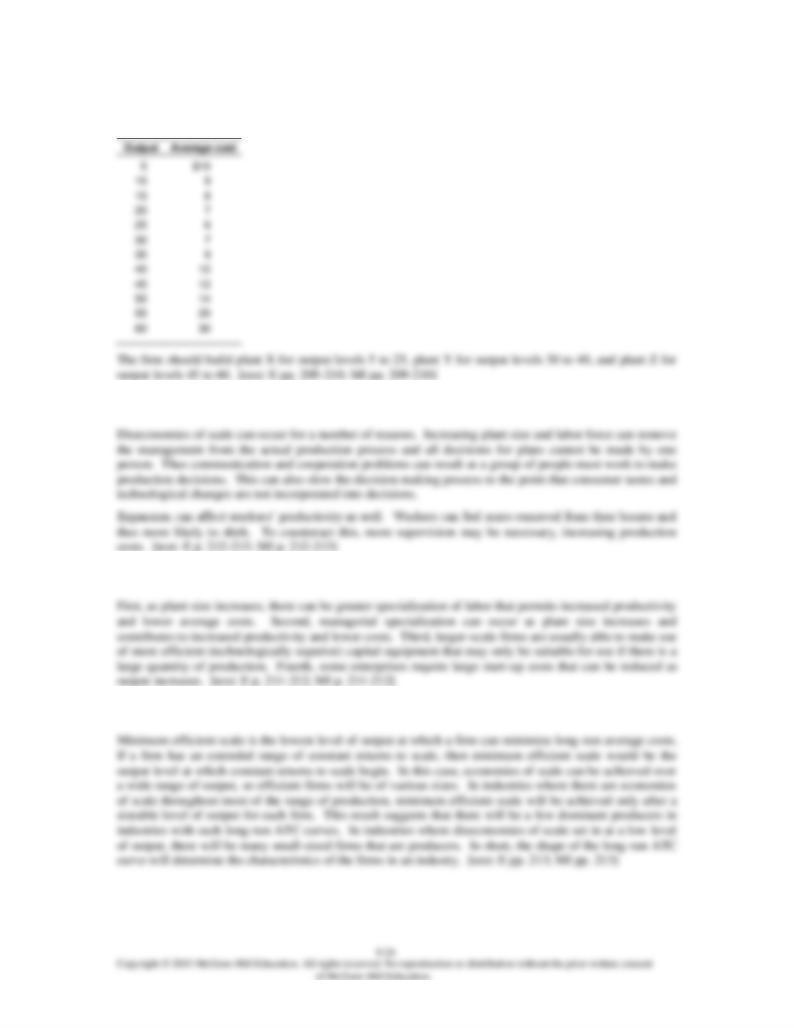
For what output levels should the firm build plant X, plant Y, and plant Z?
39. How can diseconomies of scale occur at larger capacities?
40. What factors explain economies of scale?
41. What is minimum efficient scale? What insights would it give about the size of firms in an industry?

42. The values for the long-run ATC curves of three different firms are listed in the table below.
Quantity
ATC 1
ATC 2
ATC 3
5
10
7
12
10
8
6
9
15
7
5
7
20
6
6
6
25
6
7
5
30
6
9
4
35
7
13
6
40
8
17
9
(a) Which firm faces the lowest minimum ATC?
(b) Which firm has the greatest minimum efficient scale?
43. Consider the diagram below. Curves 1–8 are the short-run curves that occur with different plant sizes.
Answer the next two questions.
(a) On the graph show the range of outputs for: (1) economies of scale; (2) diseconomies of scale:
Indicate (3) minimum efficient scale.
(b) In the long run, what plant size should the firm build if it wants to produce: (1) 6000 units; (2) 14,000
44. What effect does the increase of the price of corn have on the cost curves of a firm producing items like
corn-based cereal or tortillas?
45. What effect does the increase of the price of gasoline have on the cost curves of package delivery firms
such as Federal Express or United Parcel Service? How might the effects differ for a software firm such as
Symantec that uses the Internet?

Gasoline is a major input used in businesses involved in package delivery such as Federal Express or
46. What are some of the sources of cost savings for business start-ups in the U.S. economy such as Google,
Intel, Starbucks, and Microsoft?
47. How would a Verson stamping machine help a firm achieve economies of scale?
48. Explain how the Internet has affected the average fixed cost of a daily print newspaper.
49. Why are there two plants run by one firm that produce large commercial aircraft and thousands of plants
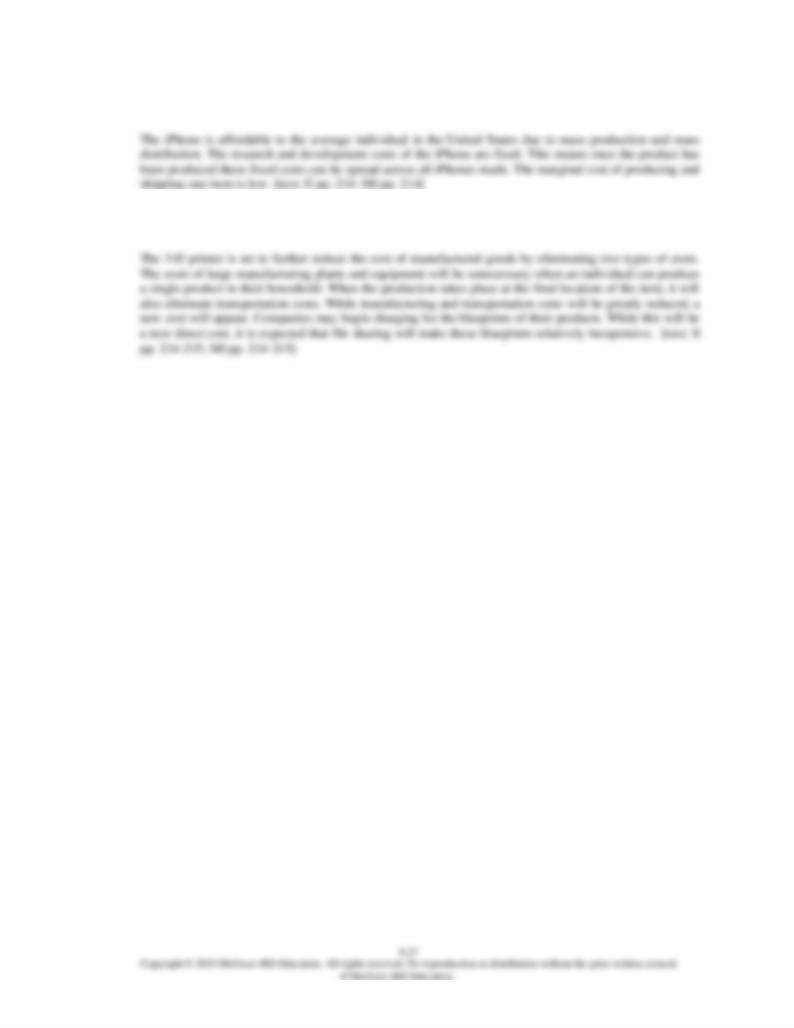
50. (Last Word) The iPhone costs billions of dollars to develop. Discuss why this product is available to the
average person in the United States.
51. (Last Word) Discuss how the 3-D printer is set to make manufactured goods more affordable for the
average person in the United States.